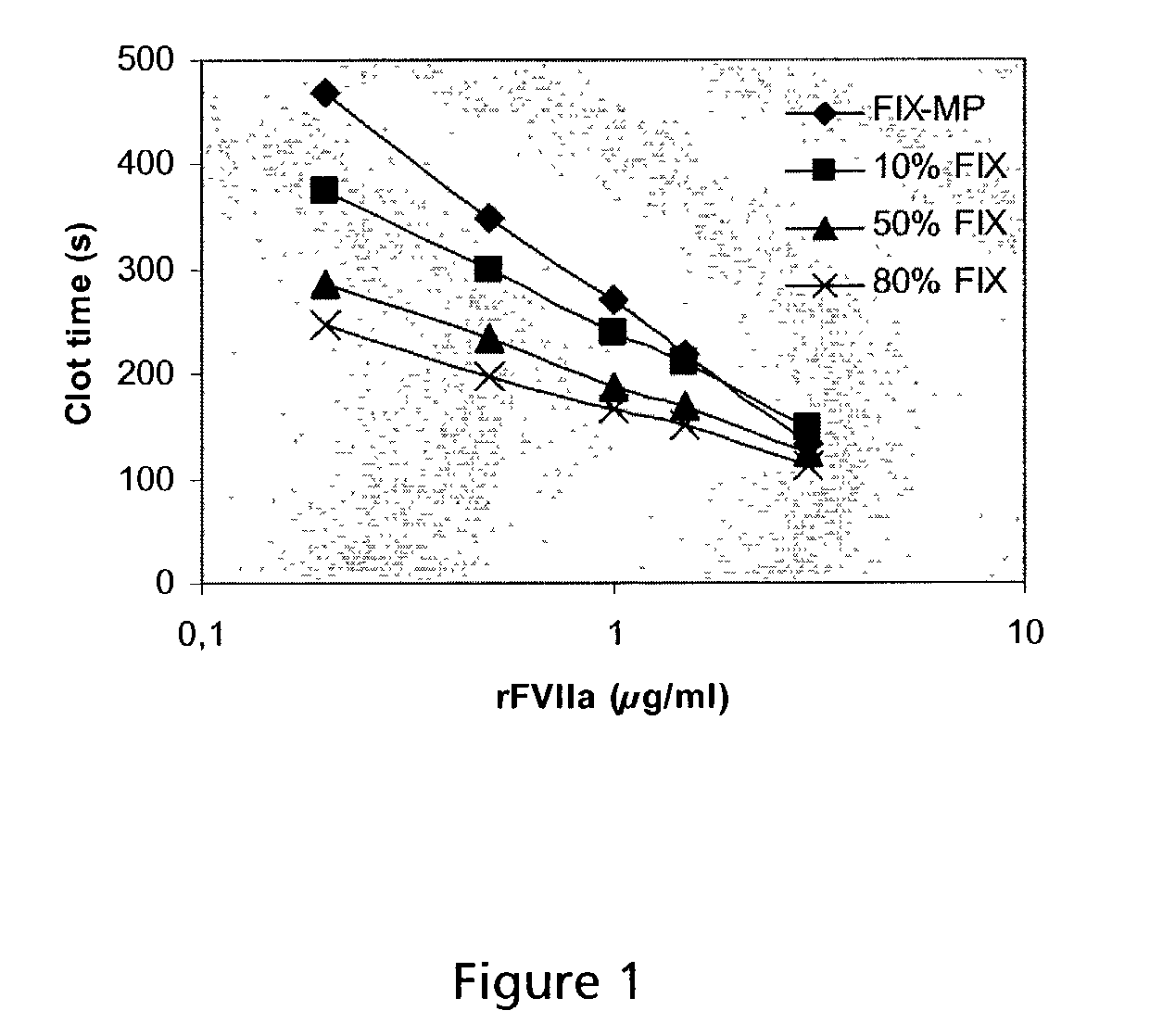Combined use of factor VII polypeptides and factor IX polypeptides
a technology of factor ix and polypeptides, which is applied in the field of combined use of factor vii polypeptides and factor ix polypeptides, can solve the problems of fibrin clot formation, reduced biological activity of protein secretion, and impaired wound healing
- Summary
- Abstract
- Description
- Claims
- Application Information
AI Technical Summary
Benefits of technology
Problems solved by technology
Method used
Image
Examples
example 1
[0268] In vivo Treatment of a Haemophilia Patient with Intracranial Bleeds
[0269] When a non-inhibitor haemophilia B patient suffering from intracranial bleeds is treated with a commercially available FIX product he will generally need between 8 and 16 injections or infusions of FIX to achieve haemostasis. The FIX infusion will intend to achieve an initial FIX plasma concentration of at least 80% of normal level followed by a plasma concentration of 50% for one week.
[0270] Such patient is treated with one dose of 90-180 .mu.g / kg b.w. of NovoSeven.RTM. (Novo Nordisk ANS, Bagsvaerd, Denmark) and a simultaneously administered FIX product, or with one dose of 90-180 .mu.g / kg b.w. of NovoSeven.RTM. (Novo Nordisk A / S, Bagsvaerd, Denmark) and a FIX product within a time separation, e.g., 5 minutes. Both products are injected through the same intravenous access. The patient experiences a reduced time to obtain bleeding arrest and a reduced number of injections to maintain haemostasis. This r...
example 2
[0271] In vivo Ttreatment of a Patient with Chronic Liver Disease with Diffuse upper Gastrointestinal Bleeds
[0272] The patient is suffering from diffuse gastric bleeds due to haemorrhagic gastritis of unknown ethiology. The patient has reduced amounts of vitamin K dependent coagulation factors, especially factors VII and IX due to decreased liver function secondary to chronic hepatitis C. The patient has been transfused with red blood cells, fluids for i.v. injection, and fresh frozen plasma which contains coagulation factor IX.
[0273] Such patient is treated with one dose of 90-120 .mu.g / kg b.w. of FVIIa and a simultaneously administered FFP product, or with one dose of 90-120 .mu.g / kg b.w., FVIIa and a FFP product within a time separation, e.g., 5 minutes. Both products are injected through the same intraveneous access. The patient experiences a reduced time to obtain bleeding arrest from multiple bleeding sites in his stomach and a reduced number of injections to maintain haemosta...
example 3
[0274] A Non-Inhibitor Haemophilia B Patient Suffering a Muscular Bleed in the Arm with Symptoms of a Compartment Syndrome
[0275] The patient is a non-inhibitor haemophilia B patient suffering from a major traumatic muscular bleed in the right arm with symptoms of a compartment syndrome.
[0276] When such a patient is treated with a commercially available FIX product he will generally need between 8 and 16 injections or infusions of FIX to achieve haemostasis. The FIX infusion will intend to achieve an initial FIX plasma concentration of at least 80% of normal level followed by a plasma concentration of 50% for one week.
[0277] Such patient is treated with one dose of 90-180 .mu.g / kg b.w. of NovoSevene (Novo Nordisk A / S, Bagsvaerd, Denmark) and a simultaneously administered FIX product, or with one dose of 90-180 .mu.g / kg b.w. of NovoSeven.RTM. (Novo Nordisk A / S, Bagsvaerd, Denmark) and a FIX product within a time separation, e.g., 5 minutes. Both products are injected through the same ...
PUM
| Property | Measurement | Unit |
|---|---|---|
| time | aaaaa | aaaaa |
| time | aaaaa | aaaaa |
| concentration | aaaaa | aaaaa |
Abstract
Description
Claims
Application Information
 Login to View More
Login to View More - R&D
- Intellectual Property
- Life Sciences
- Materials
- Tech Scout
- Unparalleled Data Quality
- Higher Quality Content
- 60% Fewer Hallucinations
Browse by: Latest US Patents, China's latest patents, Technical Efficacy Thesaurus, Application Domain, Technology Topic, Popular Technical Reports.
© 2025 PatSnap. All rights reserved.Legal|Privacy policy|Modern Slavery Act Transparency Statement|Sitemap|About US| Contact US: help@patsnap.com

